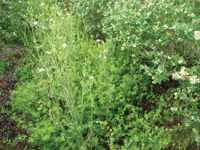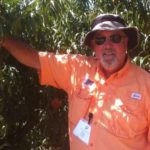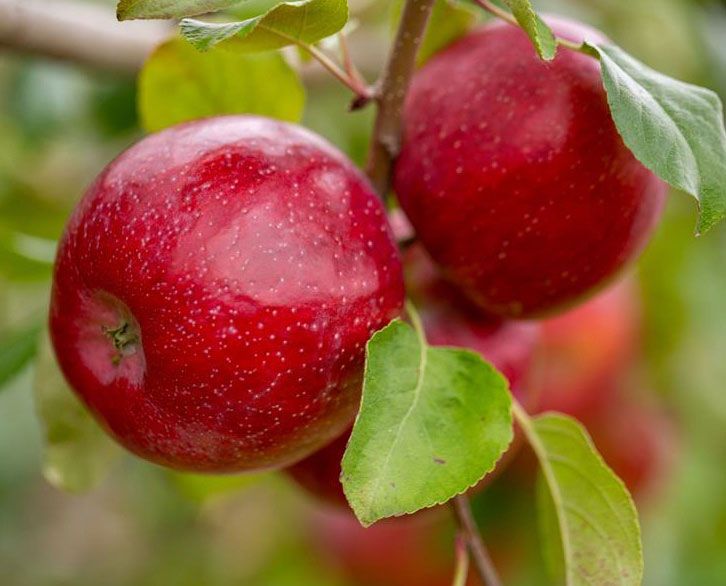Blueberry Fields Forever

Weeds pose a challenge to blueberry growers on a year-round basis. Proper identification of the weed species present in your field is the first step toward choosing the appropriate management tactic to employ.
Perennial weed species, such as bermudagrass, nutsedge, or smilax, often can become problems in Florida blueberry farms. If you are establishing a new field, management of perennial species ahead of planting is usually recommended to prevent them from establishing within the young bushes.
To help attain optimum yields, a management strategy is required to prevent them from competing with the crop for water, nutrients, and light.
Cultural Practices
Not all weed management tactics involve the use of herbicides. There are numerous cultural practices that are utilized by growers that help to reduce the impact of weeds on a blueberry farm.
Prevention is accomplished by stopping weed seeds or other plant parts from entering the blueberry rows and establishing new populations. Examples of this concept are preventing seed head production by weeds in areas adjacent to your crops such as row middles, roadways, ditch banks, and fence rows to reduce the chance of weed seeds and other plant parts from spreading to your field. Properly cleaning equipment before it enters the blueberry field also will help you to attain this goal.
Mulches prevent light from being available to weed seedlings that are trying to become established. Also, loose mulches maintain a relatively dry-root zone for weeds that might germinate and try to establish.
Manage water and nutrition by making both only available for the crop and reducing the amount that can be utilized by weedy plants.
Low-volume irrigation systems are an excellent means to direct water and nutrients — if using fertigation — to the crop. If you use dry fertilizer, set your equipment up to deliver the product to the blueberry root zone and not broadcast over the entire field.
Mechanical control can consist of mowing, cultivating, burning, and pulling weeds. At times, mechanical weed management by pulling or hoeing is done when applications of herbicide may contact and injure the crop.
Postemergence Herbicides
Non-selective postemergence herbicides might be used to eliminate hard-to-kill perennial weeds prior to planting a new field or re-planting an old one. Often there will be some established weeds in many fields just after harvest that may necessitate the application of one of these types of herbicides. Products containing the active ingredient glyphosate (Roundup, Monsanto and others) are some of the most common non-selective postemergence herbicides used in blueberries. This herbicide provides control of both annual and perennial grass and broadleaf weeds. It should be noted that contacting leaves, green stems, or exposed roots could lead to crop damage.
To avoid potential systemic injury from glyphosate, some growers choose to use alternative non-selective herbicide active ingredients like paraquat (Gramoxone Inteon and others) or glufosinate (Rely, Bayer CropScience). These two herbicides do not have systemic activity and thus will not provide good control of most perennial weeds.
Care must be taken to avoid contact of paraquat and glufosinate products with green stems or foliage of the crop as injury may result. Directed applications of carfentrazone-ethyl (Aim 2 EC, FMC Corp.) to avoid contact with green stems and leaves of the crop will control certain broadleaf weeds that are in the three- to six-leaf stage.
At times, blueberry growers utilize postemergence grass herbicides, such as products containing the active ingredients sethoxydim (Poast, BASF), or clethodim (Select, Arysta LifeScience), and fluazifop-butyl (Fusilade DX, Syngenta Crop Protection). It should be noted that Select and Fusilade DX are only labeled for non-bearing blueberries. These herbicides selectively control annual and perennial grasses, which tend to be more of a problem in the late spring and summer.
Preemergence Herbicides
Blueberry growers often will apply preemergence herbicides during the dormant period and/or soon after post-harvest pruning to help maintain a relatively weed-free crop. Since many preemergence herbicides have little to no effect on established weeds, one of the non-selective herbicides is often tank mixed with them. The active ingredient simazine (Princep and others) is utilized as a preemergence herbicide by some blueberry growers in Florida.
Recent University of Florida trials conducted in established blueberries in pine bark have indicated that a relatively new blueberry herbicide called Chateau (flumioxazin, Valent USA) has provided good to excellent residual broadleaf weed control. Trials conducted during the summer of 2009 indicated an older herbicide, which is touted as being relatively safe in younger plantings called oryzalin (Surflan and others), provided residual broadleaf control similar to Chateau. Having choices of preemergence herbicides available for use in blueberries is an advantage to growers. As with pest management programs designed to control insects and diseases, rotating products is a good way to avoid developing resistance to a particular herbicide in weeds.
Pesticide Labels
If herbicides are utilized for weed management in blueberries, the herbicide label is the source of all information about a particular product and what steps must be taken to legally and safely apply it.
Each herbicide label has specific instructions related to soil type, crop age, PHI, total applications, and many other instructions that must be followed when using a product. Always read the label before use and follow the directions.










